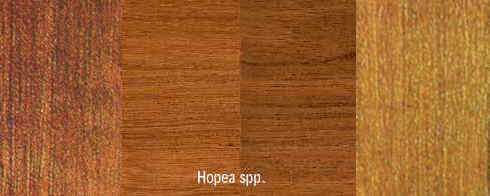
Heavy hopea (Hopea iriana)
Family: Dipterocarpaceae
Common names: Gagil, Heavy hopea, Koki, Luis, Mai takien, Manggachapui, Merawan, Thingan
Distributed in: Indonesia, Papua New Guinea (Oceania and S.E. Asia)
Common uses: Billiard-cue butts, Boat building, Broom handles, Building construction, Building materials, Cabin construction, Canoes, Construction, Crossties, Domestic flooring, Excelsior, Factory construction, Factory flooring, Flooring, Handles, Heavy construction, Joinery, Ladders , Lifeboats, Marine construction, Mine timbers, Parquet flooring, Pile-driver cushions, Piling, Poles, Railroad ties, Shafts/Handles, Shipbuilding, Sporting Goods, Sub-flooring, Tool handles, Utility poles, Wharf construction
Product sources: Species in the Hopea genus are reported to produce timbers that may fall into one of two groups, referred to by the name of the best known species in that group. The two classes are the Yacals and the Mangachapuys. Timbers in the Yacal class are harder, heavier, stronger, darker (when fresh), more resistant to decay, and more cross-grained. Commercially, the Yacals are reported to include several species of Shorea and of Vatica which produce timbers that are almost identical. The Yacals are the most abundant of the very hard, strong, and durable high-class construction timbers of the Philippine Islands.
Environment profile: Status has not been officially assessed
Tree size: Trunk diameter is 100-150 cm
Colors: the heart isPurple, Redand the sapwoodSame as heartwood, Well defined upon exposure.The grain isStreaks (figure), the textureFine to mediumand the lusterHigh
Natural durability: Susceptible to insect attack, Very durable
Odor: No specific smell or taste
Kiln Schedules: T3 - C2 (4/4) US
Drying Defects: Moderate twist/warp, Splitting
Ease of Drying: Variable
Boring: Good results
Carving: Good results
Cutting Resistance: Fairly Difficult to Very Difficult to saw
Gluing: Glues well
Mortising: Good mortising properties
Moulding: Good finishing
Movement in Service: Good finishing
Nailing: Pre-boring required
Planing: Very Good to Excellent
Resistance to Impregnation: Sapwood is permeable
Response to hand tools: Fairly Difficult to Difficult to Work
Routing recessing: Routing is easy
Sanding: Good sanding qualities
Turning: Good results
Polishing: Very Good to Excellent;
- Numerical data Metric
- Numerical data English
- Strength properties
- References
 |
 |
 |
 |
| Item |
Green |
Dry |
Metric |
| Specific Gravity |
0,74 |
0,8 |
|
| Density |
|
977 |
kg/m3 |
| Bending Strength |
1185 |
1688 |
kg/cm2 |
| Crushing Strength |
158 |
141 |
kg/cm2 |
| Hardness |
|
1020 |
kg |
| Impact Strength |
|
|
cm |
| Shearing Strength |
|
167 |
kg/cm2 |
| Stiffness |
219 |
241 |
1000 kg/cm2 |
| Tangential Shrinkage |
6 |
|
% |
| Radial Shrinkage |
3 |
|
% |
| Weight |
961 |
785 |
kg/m3 |
| Maximum Load |
|
|
cm-kg/cm3 |
| Toughness |
|
274 |
cm-kg |
| Static Bending |
909 |
1130 |
kg/cm2 |
|
 |  |  |  | | Item | Green | Dry | English | | Bending Strength | 16856 | 24010 | psi | | Crushing Strength | 2259 | 2019 | psi | | Density | | 61 | lbs/ft3 | | Hardness | | 2249 | lbs | | Maximum Crushing Strength | 9996 | 13426 | psi | | Shearing Strength | | 2386 | psi | | Static Bending | 12936 | 16072 | psi | | Stiffness | 3126 | 3440 | 1000 psi | | Toughness | | 238 | inch-lbs | | Specific Gravity | 0.74 | 0.8 | | | Weight | 60 | 49. | lbs/ft3 | | Radial Shrinkage | 3 | | % | | Tangential Shrinkage | 6 | | % | | Volumetric Shrinkage | 9 | | % | |
Bolza, E., Kloot, N. H. 1966. The Mechanical Properties of 81 New Guinea Timbers. Technological Paper No. 41. Division of Forest Products, Center for Scientific and Industrial Organization (CSIRO, Melbourne, AustraliaChudnoff, M.,1984,Tropical Timbers of the World,U.S.A. Department of Agriculture, Forest Service, Forest Products,Laboratory, Madison.Eddowes, P.J. 1977. Commercial Timbers of Papua New Guinea - Their Properties and Uses. Forest Products Research Center, Office of Forests, Department of Primary Industry, Papua New Guinea.Keating, W.G., Bolza, E.,1982,Characteristics properties and uses of timbers. South East Asia, Northern,Australia and the Pacific,C.S.I.R.O. Div. Chemical Technology,Inkata Press,1
|








